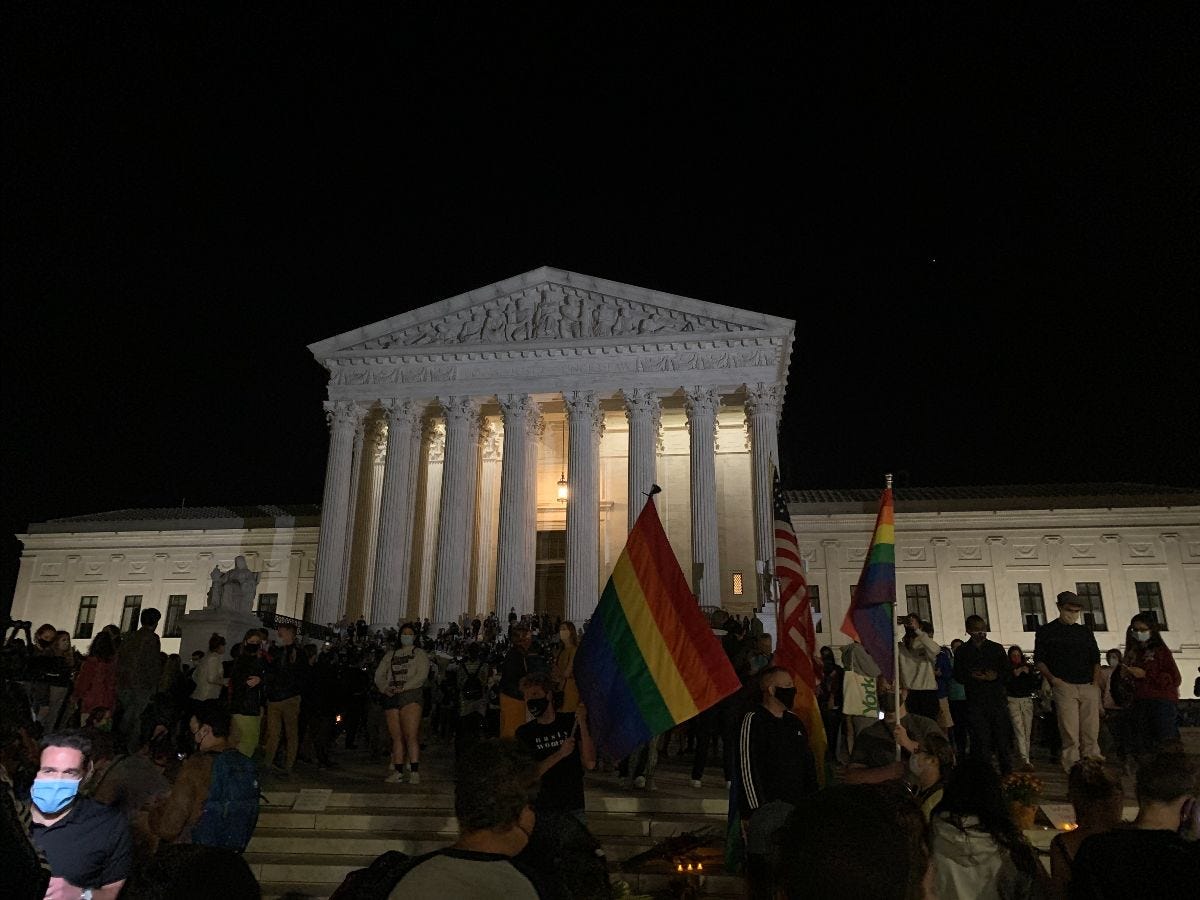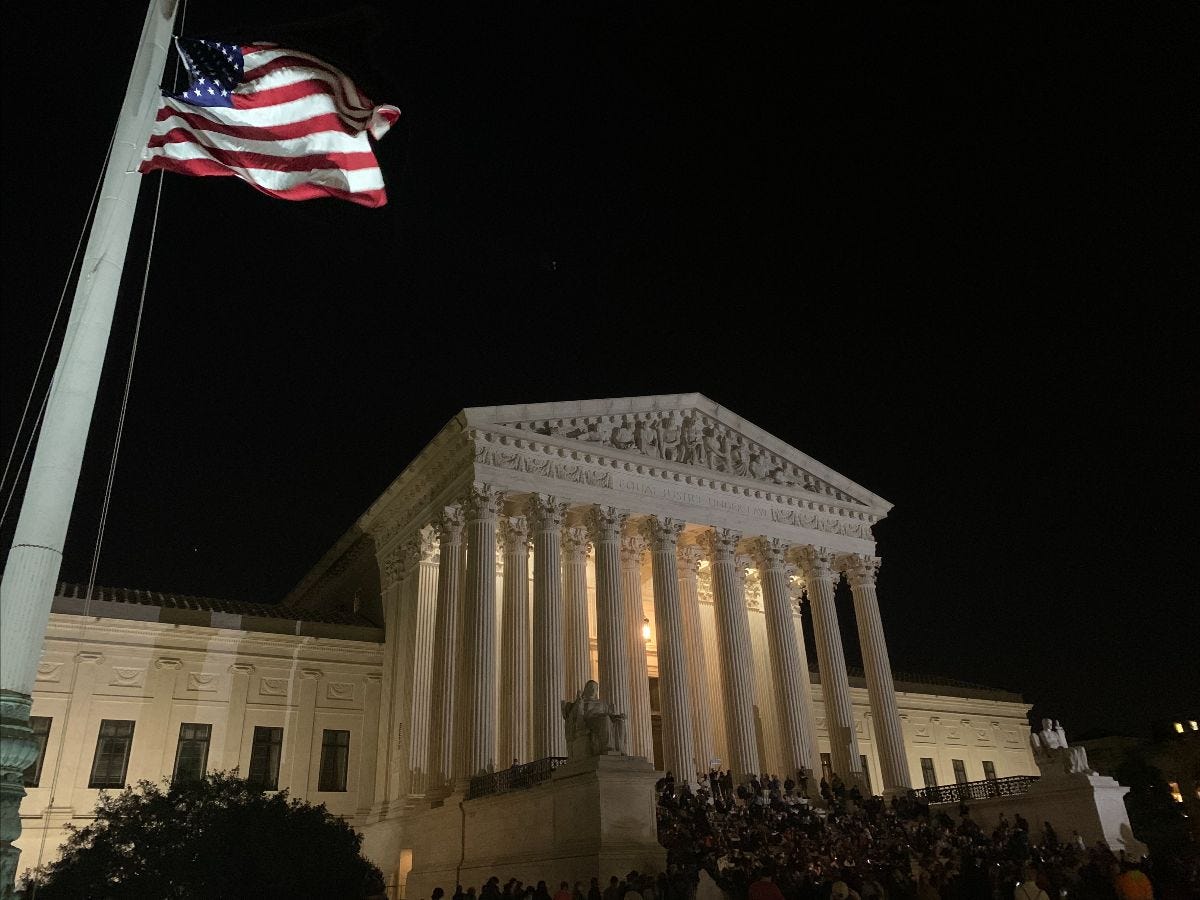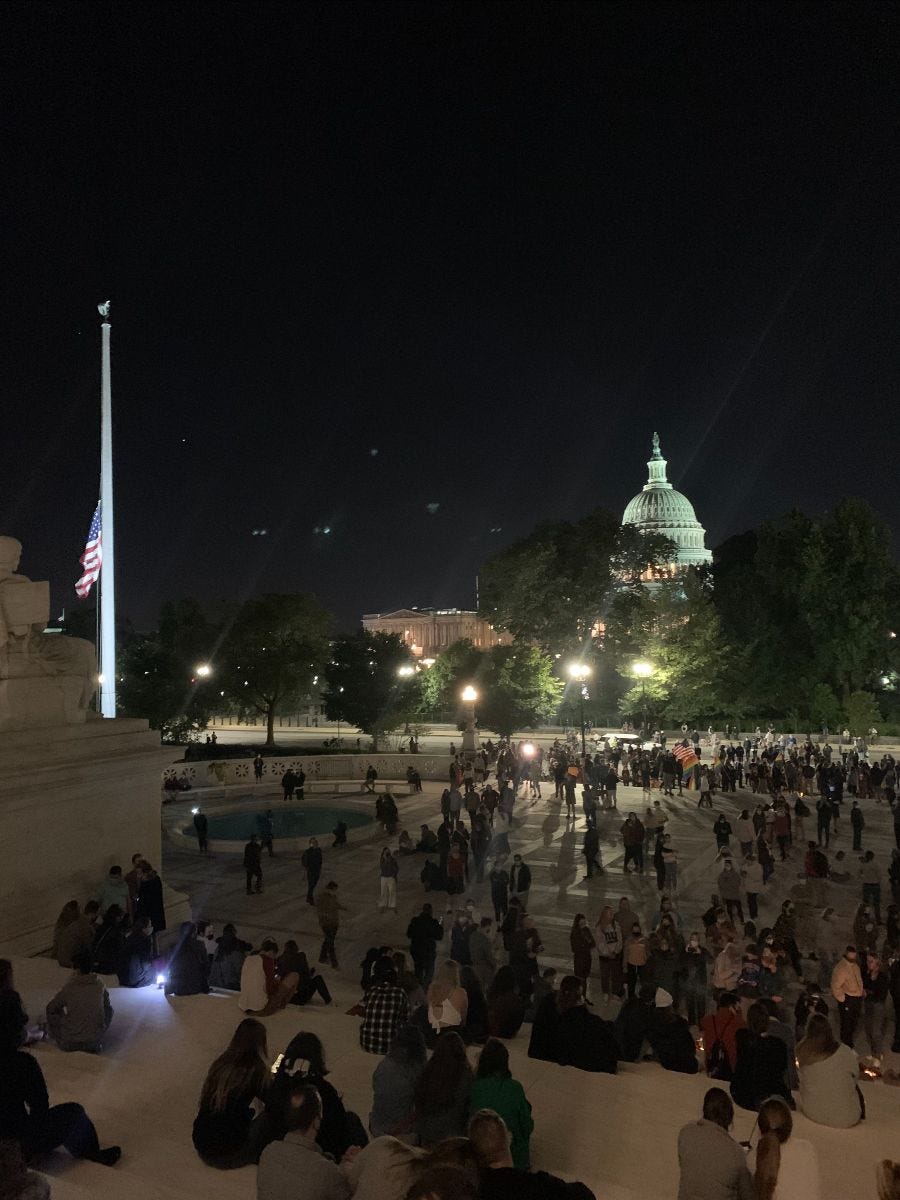It’s Saturday, September 19, 2020. Election Day is 45 days away. The first presidential debate is 10 days away. Have questions, comments, or tips? Email me.
Today: A special Saturday newsletter on Justice Ruth Bader Ginsburg’s death and the political implication. Plus, below: my reporting from the vigil held at the Supreme Court building last night.
Justice Ruth Bader Ginsburg dies at 87
Death shakes up presidential race, creates high-stakes Senate battle
Ruth Bader Ginsburg, the second woman to serve on the Supreme Court and an iconic advocate for gender equality, died on Friday at age 87.
Ginsburg had served on the Supreme Court since her appointment by President Bill Clinton in 1993; prior to becoming a federal judge, she also had a celebrated career as an attorney for the American Civil Liberty Union, paving the way for some of the feminist movement’s earliest legal victories.
But it was not until later in life that Ginsburg ascended to the status of a cultural icon — not so much for her landmark opinions, on cases such as United States v. Virginia, a groundbreaking case that found the Virginia Military Institute’s male-only admissions policy unconstitutional, but more for her fiery dissents, delivered while wearing a special “dissent collar” on her robe.
One 2013 dissent in particular, in Shelby County v. Holder (which struck down parts of the Voting Rights Act of 1965), resulted in Ginsburg’s lasting Internet fame — and gave her the moniker “Notorious RBG.”
When she died, Ginsburg was the seniormost member of the Supreme Court’s four-member liberal bloc, setting up a fierce battle as a Republican president and Senate are expected to try and fill her seat.
Senate Majority Leader Mitch McConnell (R-KY), who refused to consider President Barack Obama’s nominee to succeed the late Justice Antonin Scalia in the run-up to the 2016 election, vowed in a statement Friday that President Trump’s nominee for Ginsburg’s seat would receive a vote on the Senate floor.
“Americans reelected our majority in 2016 and expanded it in 2018 because we pledged to work with President Trump and support his agenda, particularly his outstanding appointments to the federal judiciary,” he said, adding: “President Trump’s nominee will receive a vote on the floor of the United States Senate.”
Democrats immediately accused McConnell of hypocrisy: “The American people should have a voice in the selection of their next Supreme Court Justice,” Senate Minority Leader Chuck Schumer (D-NY) said, quoting a 2016 statement from McConnell verbatim. “Therefore, this vacancy should not be filled until we have a new president.”
McConnell responded that the election-year precedent he upheld in 2016 only applies when the White House and the Senate are controlled by different parties.
If all 47 Senate Democrats oppose Trump’s nominee, McConnell can only afford to lose three members of his caucus. (Vice President Mike Pence could break the tie in a 50-50 vote.) Three Republican senators — Susan Collins (R-ME), Chuck Grassley (R-IA), and Lisa Murkowski (R-AK) — have previously said that they would not support a Supreme Court nominee until after the next presidential inauguration, although it is unclear if they will maintain that position.
Collins is one of several vulnerable Republican senators who is placed in a difficult position by the Supreme Court confirmation battle, further complicating the GOP’s hopes of keeping their Senate majority. “Keep your powder dry,” McConnell urged his members in a “Dear Colleague” letter Friday night, encouraging them to wait before taking a firm position.
Ginsburg’s death also adds fresh uncertainty to an already-turbulent presidential race, as both party bases are likely to be motivated by the prospect of an open Supreme Court seat. In 2016, Trump energized conservative voters by releasing a list of candidates he would consider to succeed Scalia, a move that is credited with helping him win the White House. He released an update to the list this year; according to Bloomberg, U.S. Court of Appeals Judge Amy Coney Barrett is seen as the frontrunner to receive the nod.
Democrats, meanwhile, have historically been less effective in energizing their supporters around judicial appointments, although the threat of Ginsburg’s seat falling into conservative hands could change that dynamic. Despite pressure from liberals and the Trump campaign alike, Democratic presidential nominee Joe Biden has so far declined to release a list of candidates he would consider nominating to the Supreme Court, although he has pledged to pick a Black woman in the past.
“Ruth Bader Ginsburg stood for all of us. She fought for all of us,” Biden said in a statement mourning her passing. He also drew the battle lines for the coming fight to succeed her: “The voters should pick a president,” Biden said, “and that president should select a successor to Justice Ginsburg.”
Trump was in Bemidji, Minnesota, when reporters informed him of Ginsburg’s passing after a campaign rally. “Wow. I didn’t know that,” the president responded. “She led an amazing life. What else can you say? She was an amazing woman, whether you agreed [with her] or not.” He did not answer any questions about his plans to fill the seat.
Hundreds gathered at the Supreme Court building to mourn Ginsburg on Friday night.
The large crowd held an impromptu vigil, as attendees of all ages came bearing bouquets of flowers and lit candles to mark the justice’s passing. From time to time, some in the crowd broke into song — including tunes such as “Amazing Grace” and “This Land is Your Land” — or applause, but for the most part, the night was marked by a sober silence.
Those in attendance spilled into the street outside the Supreme Court; many were huddled in small groups, almost all masked and some in tears.
“This is the death of an American icon and an American legend,” one of the mourners, 35-year-old lawyer Nina Tandon, told Wake Up To Politics, adding: “She protected civil rights for Americans for decades. She really galvanized people to come together to protect gender rights and voting rights.”
Ginsburg “gave me hope, and she inspired me to carry the work on,” said a civil rights lawyer who declined to be identified because of her role in the federal government.
“It felt like this was the place to be,” Ariel Schwartz, a 27-year-old teacher, told WUTP. She also said that Ginsburg had “felt like a last hope.”
“Now that she’s gone,” Schwartz added, “it feels like there is no hope, but hopefully that is not the case.”
Even as the gathering grew to over 1,000 attendees, most remained quiet, save for a few chants and singalongs. Only once did someone take to a megaphone and speak to the entire crowd: when Alison Rogers, a 30-year-old attorney, led the gathering in a recitation of the Kaddish, the Jewish mourner’s prayer.
“It brings peace and comfort,” Rogers told Wake Up To Politics, explaining why she decided to share the blessing. “It’s nostalgic for a lot of people. It should be said when a Jewish person passes away. It’s an important part of our tradition and it makes things feel in place, like they’re being done as they should be.”
Holding back tears, Rogers said that Ginsburg, a “personal hero” of hers, was an “embodiment” of Jewish values. A lifelong Jew, Ginsburg died on Erev Rosh Hashanah, the beginning of the Jewish New Year. Shofars, an ancient instrument which are traditional parts of the holiday, also occasionally sounded outside the Supreme Court building throughout the night.
At around midnight, the crowd began to dissipate as the vigil morphed into a brief march, with demonstrators chanting, “Honor her wishes!”
According to NPR, Ginsburg dictated a final statement to her granddaughter just days before her death: “My most fervent wish is that I will not be replaced until a new president is installed.”
Thanks for reading! If you enjoy Wake Up To Politics, please consider donating to support me and my work, listening to my podcast with St. Louis Public Radio, and spreading the word about the newsletter to your friends and family. If this newsletter was forwarded to you, go to wakeuptopolitics.com to subscribe and learn more.









